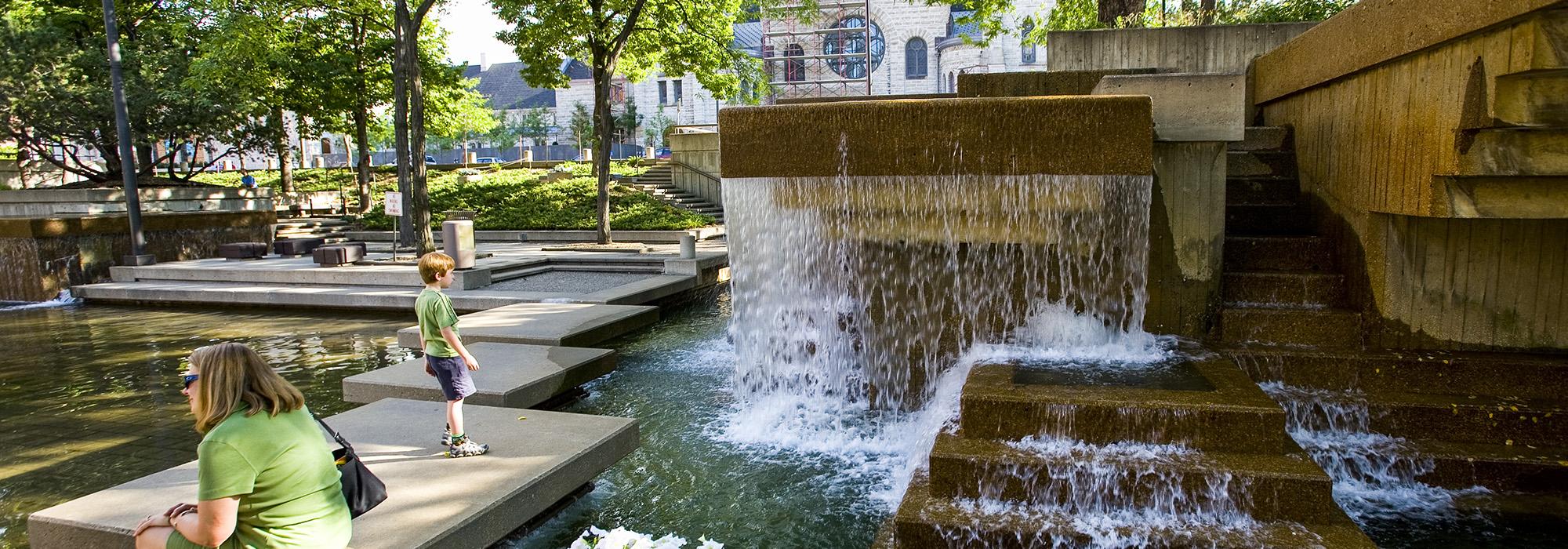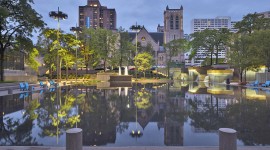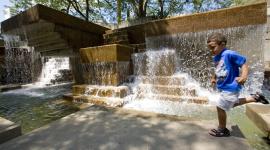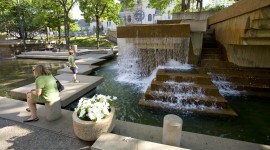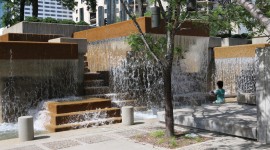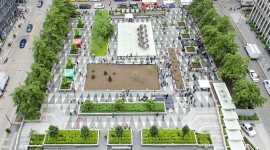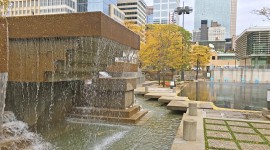Endangered Peavey Plaza now Listed in the National Register of Historic Places
Media Contact: Nord Wennerstrom | T: 202.255.7076 | E: nord@tclf.org
Endangered Peavey Plaza now Listed in the National Register of Historic Places
Innovative Modernist Work by American Society of Landscape Architects 2004 Design Medal winner, landscape architect M. Paul Friedberg
Washington, DC (January 17, 2013) –The Cultural Landscape Foundation (TCLF) today announced that Peavey Plaza, a Modernist urban plaza in downtown Minneapolis, MN designed by landscape architect M. Paul Friedberg that opened in 1975, has been listed in the National Register of Historic Places. The designation was made official on January 14, 2013 (Reference# 12001173) and will be published on January 25, 2013. Peavey is the progenitor of the “park plaza” style of design that combines the hardscape of European plazas and American green space. The plaza, which is currently threatened with demolition by the City of Minneapolis, is considered to be the finest surviving example of Friedberg’s work from the period. Friedberg, a recipient of the American Society of Landscape Architects (ASLA) Design Medal in 2004, the organization’s highest award, is one of the nation’s leading landscape architects. Peavey joins an elite group of works on the National Register – of the more than 88,000 sites on the Register, less than 2,500 have significance in landscape architecture. Historical consultant Charlene Roise, president of Minneapolis-based Hess, Roise and Company, prepared Peavey Plaza’s National Register nomination.
“Peavey Plaza’s National Register designation is a victory of Paul Friedberg’s brilliant design, for Modernist landscape architecture and further undermines the City of Minneapolis’ ill-advised demolition plans,” said Charles A. Birnbaum, TCLF founder and president.
About Peavey Plaza During the successful urban renewal projects of the 1960s, the city of Minneapolis hired landscape architect M. Paul Friedberg to design Peavey Plaza to connect with Nicollet Mall, the city’s new downtown pedestrian mall. Peavey’s Modernist design vocabulary is similar to other Friedberg projects in New York (Riis Park Plaza, demolished in 2000) and Washington, DC (Pershing Park): amphitheater- style seating oriented around the sunken plaza/pool basin (filled with water during the summer or frozen in winter for skating), cascading and spraying fountains to animate the space, lawn terraces, many sculptural objects, and ample opportunities for large- and small-scale gatherings. While the plaza was originally designed as a “front yard” for the Minnesota Orchestra’s new concert hall, it became an urban oasis for downtown inhabitants. The waterfalls absorb city noise and small garden “rooms,” delineated by groves of honey locusts, create a sense of human intimacy that softens the modern angular surfaces.
About the Efforts to Prevent Peavey’s Demolition On Wednesday, October 19, 2011, following what the City of Minneapolis claimed was a transparent review process, a new design for Peavey Plaza was unveiled. The existing plaza would be razed because, the City argued, there were “no reasonable alternatives” to demolition. On May 17, 2012, to counter the City’s claim, TCLF and Preservation Alliance of Minnesota (PAM) unveiled a new design concept for Peavey. The design, first published in the New York Times,was developed pro bono at TCLF’s request by Friedberg and MPFP llc / M. Paul Friedberg & Partners. The new concept addresses concerns raised by the City and neighboring Orchestra Hall about accessibility, safety, revenue generation and other issues while maintaining the site’s signature design elements. Preliminary budget estimates find this alternative rehabilitation scheme to be less expensive or comparably priced to the new plaza the City has proposed to build on the site.
On June 28, 2012, TCLF and PAM filed suit against the City of Minneapolis to protect Peavey Plaza from demolition (click here for a copy of the complaint). The organizations argue that the City’s intent to demolish the Plaza is a violation of the Minnesota Environmental Rights Act (MERA); specifically, Peavey Plaza is a natural resource entitled to protection under MERA, which defines historic resources as among protected natural resources.
The Plaza is adjacent to Orchestra Hall, which is undergoing a $45 million renovation. The City of Minneapolis claims there are no reasonable alternatives to the demolition of Peavey Plaza, despite Friedberg’s adaptive reuse concept. On April 17, 2012, the Minneapolis Heritage Preservation Commission (HPC) voted 8-1 to deny demolition of the plaza and to order the preparation of a historic designation study. Subsequent actions by the Minneapolis City Council in May 2012 overturned the HPC’s decision and reaffirmed the City’s plans to demolish Peavey.
The Minnesota Environmental Right Act or "MERA" is a state law designed to preserve Minnesota's natural and historic resources for future generations of Minnesotans. MERA protects natural resources from pollution, impairment or destruction. Under Section 116B.02, Subd. 4, this protection extends to historical resources like Peavey Plaza. MERA gives citizens, and groups like TCLF and PAM, the right to ask a court to enjoin the City of Minneapolis from demolishing historic resources and to force the City to consider reasonable alternatives to demolition.
Peavey Plaza was featured in TCLF’s Landslide 2008: Marvels of Modernism and PAM’s 2008 list of Minnesota’s 10 Most Endangered Historic Places. Peavey Plaza is also the cover image for Shaping the American Landscape: New Profiles from the Pioneers of American Landscape Design Project, which chronicles more than 250 years of American landscape design, and the latest edition of the National Trust for Historic Preservation’s Forum Journal.
About The Cultural Landscape Foundation (TCLF)
TCLF provides people with the ability to see, understand, and value landscape architecture and its practitioners, in the way many people have learned to do with buildings and their designers. Through its Web site, lectures, outreach, and publishing, TCLF broadens the support and understanding for cultural landscapes nationwide to help safeguard our priceless landscape heritage for future generations.



